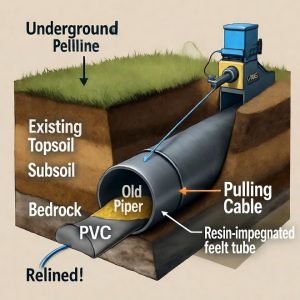Infrastructure Innovation: Why Sewer Technology Should Be Part of Every Green Policy Discussion
 Urban infrastructure silently carries the weight of modern civilization. Beneath every street, a complex network of pipes ensures sanitation, yet these systems often age faster than they are repaired. This neglect leads to leaks, soil contamination, and unnecessary waste. What many people overlook is that the path toward sustainable cities is not just lined with solar panels or electric buses, but also with smarter underground solutions that protect the environment where we cannot see it.
Urban infrastructure silently carries the weight of modern civilization. Beneath every street, a complex network of pipes ensures sanitation, yet these systems often age faster than they are repaired. This neglect leads to leaks, soil contamination, and unnecessary waste. What many people overlook is that the path toward sustainable cities is not just lined with solar panels or electric buses, but also with smarter underground solutions that protect the environment where we cannot see it.
One such breakthrough technology, sewer relining (relinen riool), has become a quiet hero in the conversation about green innovation. It allows damaged pipelines to be repaired internally without excavation, saving tons of concrete and soil from being displaced. This approach aligns perfectly with modern sustainability goals, reducing carbon emissions from heavy machinery and preventing harmful runoff into ecosystems. Yet, despite its clear benefits, it still struggles for recognition in national and local green policy discussions.
Why Sewer Technology Deserves a Seat at the Policy Table
Green policies tend to focus on visible projects like renewable energy or public transport upgrades. While these initiatives are vital, underground infrastructure is equally important for long-term environmental protection. Traditional pipe replacement is a messy, carbon-heavy process. It requires digging up roads, hauling away debris, and pouring new materials—all of which create emissions and disrupt communities. In contrast, relining uses specialized resin-coated materials to seal and strengthen old pipes from within, dramatically cutting environmental costs.
Policy makers have an opportunity to expand their sustainability framework. By including sewer technology innovations in green infrastructure plans, governments can help cities reduce waste, conserve resources, and extend the lifespan of existing systems. This shift would encourage municipalities to prioritize maintenance over replacement, a mindset that fits perfectly with circular economy principles.
Environmental Benefits That Make a Difference
The environmental advantages of relining are measurable and meaningful. Studies have shown that this method can reduce carbon emissions by up to 90% compared to traditional excavation and replacement. Because the process is trenchless, it eliminates the need for massive machinery and significantly reduces the impact on traffic and local businesses. Fewer construction hours mean less noise and pollution, leading to a cleaner, quieter urban environment.
Furthermore, sewer relining (relinen riool) reduces contamination risks. Leaks in old pipelines can allow wastewater to seep into soil and groundwater, threatening public health and local ecosystems. By sealing pipes efficiently, relining prevents this leakage, ensuring cleaner water systems for the future.
The Role of Government in Supporting Sustainable Repairs
Government backing is critical to make sustainable repair technology a mainstream solution. Incentives, such as tax benefits for eco-friendly contractors or grants for municipalities adopting green infrastructure methods, can accelerate the transition. Establishing clear regulations and quality standards also helps ensure that relining practices maintain both safety and environmental integrity.
Public awareness campaigns could also change how cities view their underground systems. Much of the resistance to adopting new infrastructure technology stems from lack of knowledge. When citizens understand that modern sewer repairs can cut emissions and save public funds, they are more likely to support projects that may seem invisible but have enormous benefits.
Challenges and Opportunities Ahead
Despite its advantages, relining technology faces hurdles that prevent it from wider adoption. Cost perceptions, lack of technical expertise in smaller municipalities, and outdated regulations can slow down progress. However, these challenges also present opportunities for innovation and education. Training programs, public-private partnerships, and sustainability-focused urban planning can all drive change.
Countries investing in smart infrastructure have already seen the rewards. In many parts of Europe, trenchless sewer rehabilitation is standard practice. Cities are reporting lower maintenance costs and reduced carbon footprints. This success story should inspire other nations to follow suit and make underground sustainability a visible part of political dialogue.
Looking Forward: A Greener Underground Future
The future of sustainable infrastructure depends on seeing value beyond the surface. Clean water systems, efficient waste management, and low-impact repair technologies are essential to building eco-friendly cities. Sewer relining (relinen riool) represents a practical and proven way to advance this vision, offering an immediate environmental return with long-term financial savings.
By integrating this technology into green policy discussions, governments can take a decisive step toward sustainability that begins beneath our feet. Supporting eco-friendly repair solutions is not only about fixing what is broken, but about reshaping how we maintain the world we live in. Every repaired pipe, every reduced emission, and every policy that supports such innovation brings us closer to a future where infrastructure and environment thrive together.
